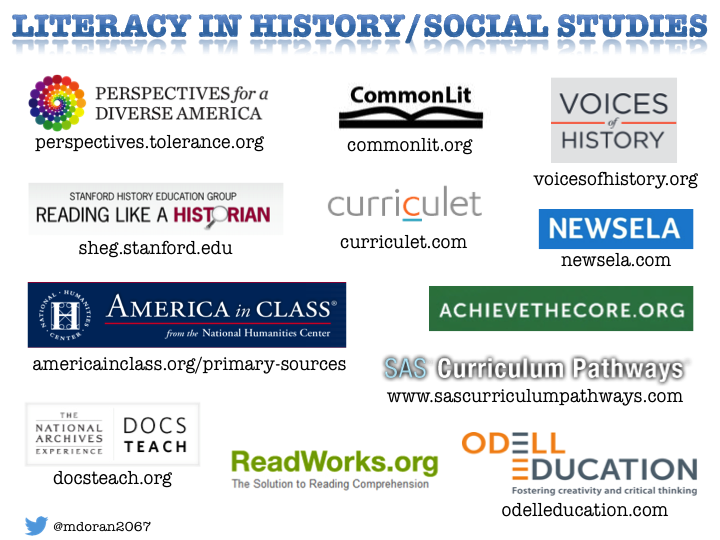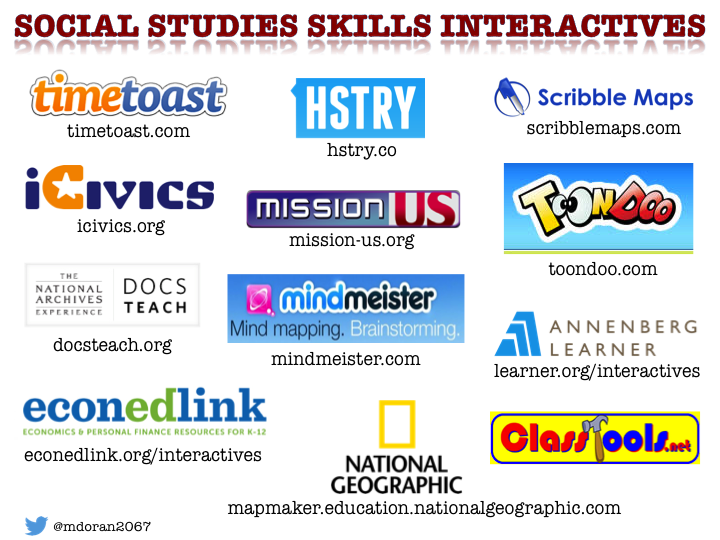Reflections and Collections for the 21st Century Social Studies Classroom
|
By Matt Doran I had been planning to post this article this week when I learned of the unexpected passing of Grant Wiggins on May 26, 2015. Wiggins was the co-author of Understanding by Design. His work on backward design and inquiry learning has been a powerful influence on my curriculum and professional development work over the years. The article below is written in his memory. For Wiggins' take on UbD and C3, see the blog article, Questions about Questions: NCSS and UbD. Why Use Inquiry Learning in Social Studies?Inquiry involves the pursuit of knowledge and understanding by means of questioning. Inquiry learning is inextricably tied to the disciplines of history and social sciences. The term “history” is derived from the Greek ἱστορία, historia, meaning “inquiry, knowledge acquired by investigation.” History is not a closed narrative recitation of facts, but rather an open investigation that is continually researched, discussed, and debated. Historians seek not only to answer questions about “who, what, and when,” but also “why and how.” They also search for patterns and connections and draw conclusions about historical significance. While historians focus on questions from the past, social scientists use scientific inquiry and research data to draw conclusions about the relationships among individuals in society. Geographers, sociologists, economists, and political scientists use inquiry to help us understand the world and solve the problems we encounter. How Should Teachers Develop Questions for Inquiry Learning? Inquiry learning starts by posing questions or problems. Good inquiry learning, therefore, relies on the use of good questions. The Understanding by Design framework (UbD) provides one approach for helping teachers frame effective questions. UbD emphasizes beginning with the end goals in mind. The UbD process consists of three planning stages: 1) identifying desired results; 2) determining acceptable evidence; and 3) planning learning experiences and instruction. Developing Overarching Essential Questions UbD stage 1 starts with big ideas and enduring understandings. Big ideas are transferrable concepts that anchor the course and focus the curriculum. Big ideas in social studies may focus on abstract concepts such as:
They may also be framed as issues or conflicts:
The five themes of geography can also function as the big ideas:
Enduring understandings are derived from the big ideas and serve as the “moral of the story.” For example, the big ideas of common good and individual liberties could be expressed as: “Democratic governments must balance the common good with individual liberties.” In geography, an enduring understanding about human-environment interaction could read: “Physical environments influence human activities and human activities alter the physical environment.” Flowing from the big Ideas and enduring understandings, overarching essential questions are broad questions that help shape the direction of units of study throughout an entire course. According to UbD, overarching essential questions:
Table 1A. Sample Overarching Essential Questions in Social Studies
Graphic Organizer 1A. Planning Overarching Essential Questions
Developing Compelling Questions The College, Career, and Civic Life (C3) Framework, developed by the National Council for the Social Studies, helps guide the development of unit-specific compelling and supporting questions. C3 uses an Inquiry Arc based on four dimensions of social studies inquiry: 1) Developing questions and planning inquiries; 2) Applying disciplinary concepts and tools; 3) Evaluating sources and using evidence; and 4) Communicating conclusions and taking informed action. Dimension 1 guides the planning of inquiry-based units. The C3 framework states:
In the video below, Kathy Swan, lead writer of the C3 framework, explains two important criteria for compelling questions. Compelling questions must be intellectually meaty and student-friendly. Table 1B. Sample Compelling Questions
 Graphic Organizer 1B. Planning Compelling and Supporting Questions Adapted from the Inquiry Design (IDM) Blueprint: http://www.c3teachers.org/idem/
How Should Teachers Implement Essential and Compelling Questions? Essential questions and compelling questions drive student inquiry. Overarching essential questions should be introduced at the beginning of the course, and revisited throughout the year. Compelling questions should be introduced at the beginning of the unit and lesson and guide student assignments and activities throughout the unit. Strategies for Implementing Overarching Essential Questions Overarching essential questions can be placed on large poster-size paper and posted on the classroom walls. These posters serve as reference points for the teacher and students. Allow space on the posters for the class to record thoughts about the essential questions. At the beginning of the course, conduct a class brainstorm on the board and write some of the key ideas on the posters. Repeat the activity quarterly or with each unit and add the new information using a different color marker each time. This will allow students to see their growth in understanding throughout the course. Students can also keep an essential questions journal to record their reflections on these questions at various points throughout the course. Journal entries also allow for creative responses. Students may draw a cartoon, write a poem or song, or create a visual metaphor to demonstrate their understanding of the questions. Discussion strategies provide opportunities for collaborative reflection on the essential questions. As the questions are revisited, students should be asked to connect the essential questions with the specific content of each unit, with compelling questions serving as further discussion points. While essential questions do not have a single correct answer, they can shape essays in pre- and post-assessments to measure students’ growth in historical thinking and writing. Teachers can assess students’ responses using an evidence-based essay rubric that measures how well students supported their claims with evidence and reasoning. Strategies for Implementing Compelling Questions Compelling questions are unit-specific and should be introduced at the beginning of each unit or lesson. The C3 framework recommends that students take an active role in the development of compelling questions. Teachers may want to develop one or two compelling questions and have students come up with a third question for a particular unit. Keep in mind that compelling questions are only the beginning of the inquiry. Supporting questions should also be crafted to guide students’ inquiry. The strategies contained in the document provide tools for students to research, discuss, and debate these questions, and guidance on performance-based assessment development. Many compelling and supporting questions work well with a detective model approach to history. Like detectives, historians define a specific problem to solve, ask meaningful questions, evaluate the evidence, and draw tentative conclusions. The evidence comes in the form of primary and secondary sources, but is always incomplete. Detectives and historians must try to separate fact from opinion and remain open to a variety of ways the evidence may be interpreted. To begin the detective model, ask students ask students to give examples of detective or investigative television shows or movies they have seen. Ask students to brainstorm a list of skills that a good detective or investigator needs to have. Explain that throughout this course, students will learn that history is not a giant list of facts and figures to memorize. Rather it is an investigation into the past. Ask: Which of these skills are necessary to study history effectively? View a short video clip of a detective show and discuss how the detectives gather and use evidence. Classic examples from the television detective show Dragnet are available on YouTube: https://www.youtube.com/user/50sDragnet. Graphic Organizer 1C. Investigating History
What Resources Are Available for Inquiry Learning? Publications
Wiggins, Grant P., and Jay McTighe. Understanding by Design. Expanded 2nd ed. Alexandria, VA: Association for Supervision and Curriculum Development, 2005 McTighe, Jay, and Grant P. Wiggins. Understanding by Design: Professional Development Workbook. Alexandria, Va.: Association for Supervision and Curriculum Development, 2004. National Council for the Social Studies. College, Career, and Civic Life Framework for Social Studies State Standards: Guidance for Enhancing the Rigor of K-12 Civics, Economics, Geography, and History. Silver Spring, MD: NCSS, 2013. http://www.socialstudies.org/system/files/c3/C3-Framework-for-Social-Studies.pdf Swan, Kathy and John Lee, ed. Teaching the College, Career, and Civic Life (C3) Framework: A Guide to Inquiry-Based Instruction in Social Studies. Silver Spring, MD, NCSS, 2014 Lesh, Bruce A. "Why Won't You Just Tell Us the Answer?": Teaching Historical Thinking in Grades 7-12. Portland, Me.: Stenhouse Publishers, 2011. Wineburg, Sam, Daisy Martin and Chauncey Monte-Sano. Reading Like a Historian: Teaching Literacy in Middle and High School History Classrooms. Columbia: Teachers College Press, 2012. Websites Stanford History Education Group. Reading Like a Historian. https://sheg.stanford.edu/rlh University of Maryland Baltimore County. History Labs: A Guided Approach to Historical Inquiry in the K-12 Classroom. http://www.umbc.edu/che/historylabs/ National Council for the Social Studies. C3 Teachers: College, Career & Civic Life. http://www.c3teachers.org/ For the past ten years, I have been developing district micro-curriculum--course-specific unit plans and model lessons. This summer I am tackling a project that will yield a broader view of secondary social studies. The Social Studies Instructional Framework will be a macro-curriculum outlining the elements of successful social studies units, applicable to all courses and grade levels, 6-12.
This macro-curriculum will extrapolate the underpinning pedagogy from the course-specific lessons and synthesize the parallel work I have been generating for professional development workshops. Through a combination of narrative, samples, and blank organizers, the Social Studies Instructional Framework will help guide teachers in the preparation of units and lessons (or the adaptation of existing ones). The end product will essentially be a condensed version of a social studies methods textbook. As I work through the Social Studies Instructional Framework this summer, I will post drafts on this blog to invite feedback from teachers and scholars. Today, I have included the draft outline of the chapters and sections. Your comments are welcome. What would you include, or not include? Elements of Successful Social Studies Units 1. Inquiry Questions
2. Performance-Based Assessment
3. Vocabulary Development
4. Graphically-Organized Notes
5. Social Studies Skills
6. Reading Like a Historian
7. Evidence-Based Writing
8. Discussion and Debate
9. Role-Play and Simulation
10. Relevance, Real World Connections and Civic Engagement
|
Blog Categories
All
Blog Archives
August 2020
|


 RSS Feed
RSS Feed

5/29/2015
2 Comments